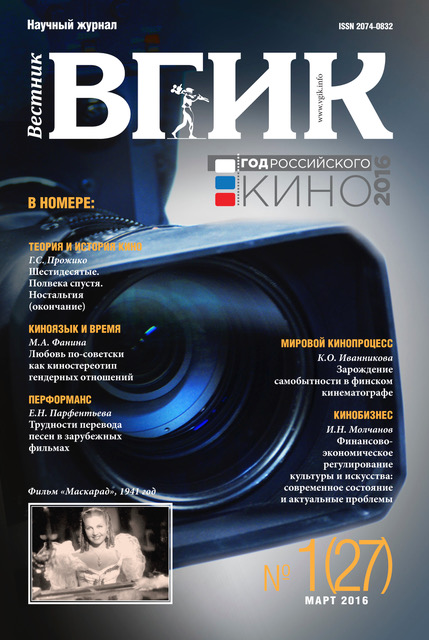Landscape as a Leitmotif of a Film
- 作者: Shakhovskaya N.A1
-
隶属关系:
- VGIK
- 期: 卷 8, 编号 1 (2016)
- 页面: 43-53
- 栏目: PERFORMANCE | ART OF PRESENTATION
- URL: https://journals.eco-vector.com/2074-0832/article/view/14726
- DOI: https://doi.org/10.17816/VGIK8143-53
- ID: 14726
如何引用文章
全文:
详细
The article examines the landscape as a significant element of the film’s plastic composition and semantic structure. Taking Andrey Konchalovsky’s “The Postman’s White Nights” as an example, the author analyses the role of documentary aesthetics in describing the relationship between humanity and nature, revealing the estrangement of the two realms.
作者简介
Nadezhda Shakhovskaya
VGIK
编辑信件的主要联系方式.
Email: editor@vestnik-vgik.com
Post-Graduate Student, Aesthetics, History and Theory of Culture
参考
- Марголит Е.Я. Живые и мертвое. Заметки к истории советского кино 1920-1960-х годов. - СПб.: Мастерская «Сеанс», 2012. - 560 с.
- Мильдон В.И. Открылась бездна.. Образы места и времени в классической русской драме. - М.: Изд.-во «Артист. Режиссер. Театр» СТДРСФСР, 1992. - 351 с.
- Разлогов К.Э. Экран как мясорубка культурного дискурса // Экранная культура. Теоретические проблемы: сб. статей / отв. ред. К.Э. Разлогов. - СПб.: «ДМИТРИЙ БУЛАНИН», 2012. - 752 с.
- Третьяков Н.Н. Образ в искусстве. Основы композиции. - Свято-Введенская Оптина Пустынь, 2001. - 264 с.
- Флоренский П.А., священник. Статьи и исследования по истории и философии искусства и археологии / сост. игумена Андроника (А.С. Трубачева); ред. Игумен Андроник (А.С. Трубачев). - М.: Мысль, 2000. - 446с.
- Эйзенштейн С.М. Неравнодушная природа. Т. 2. - М.: Музей кино. Эйзенштейн-центр, 2006. - 624 с.
补充文件







